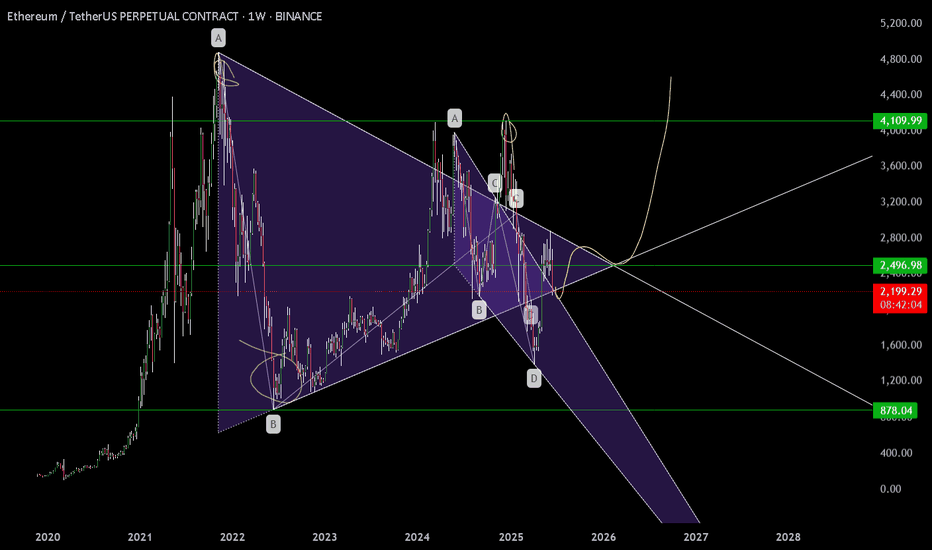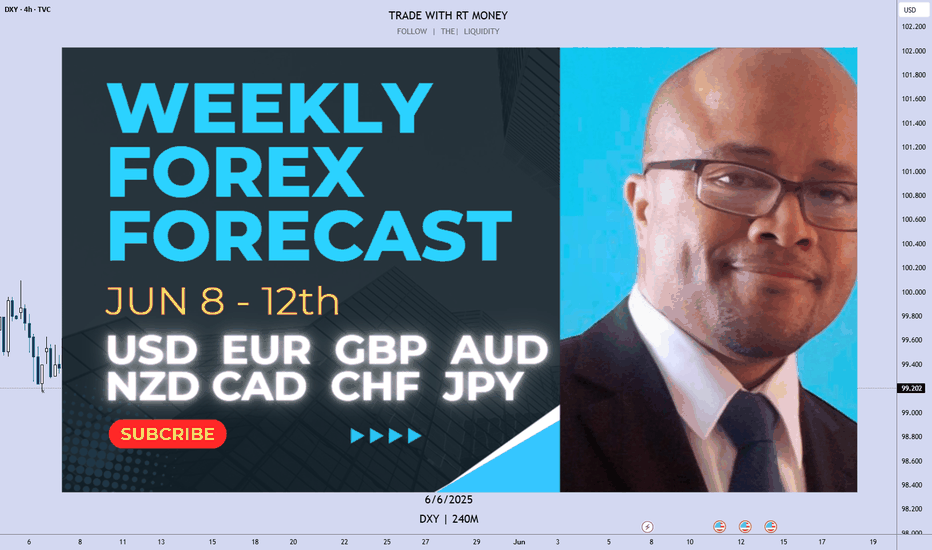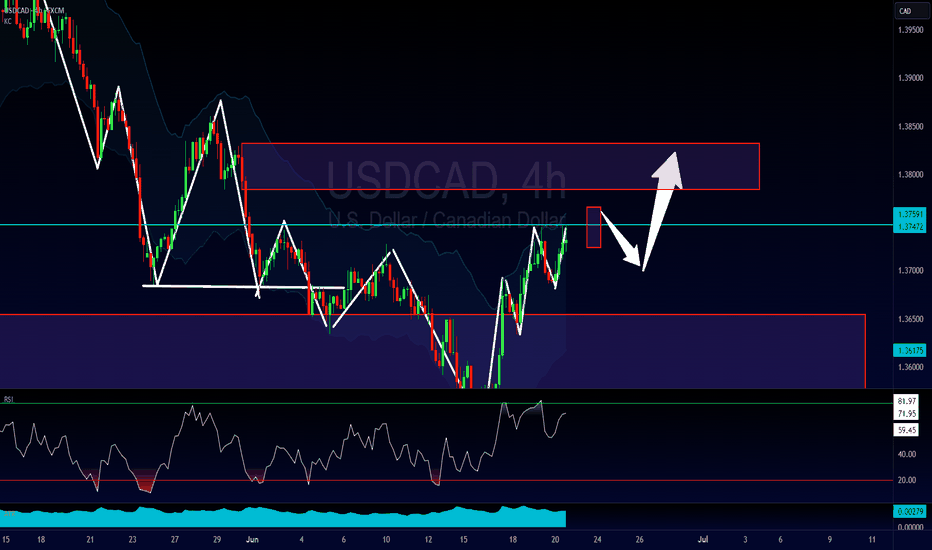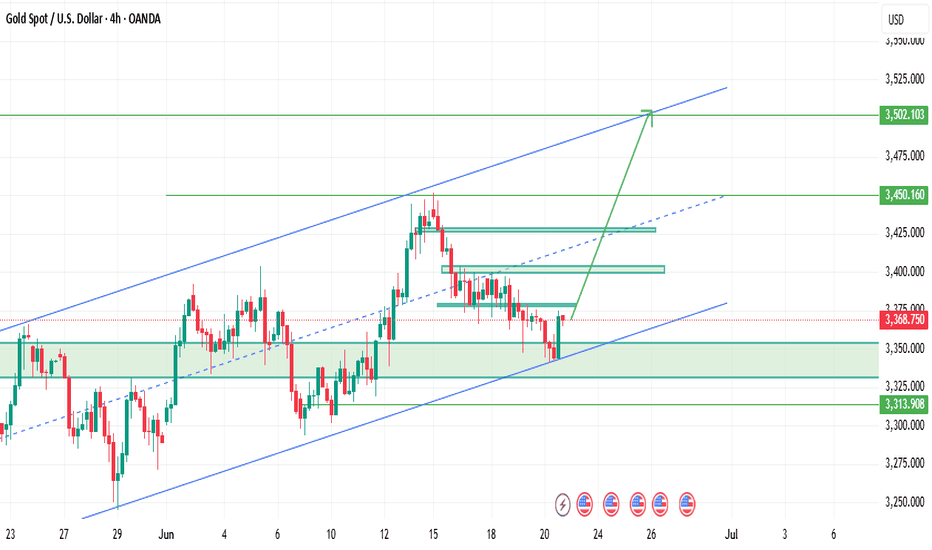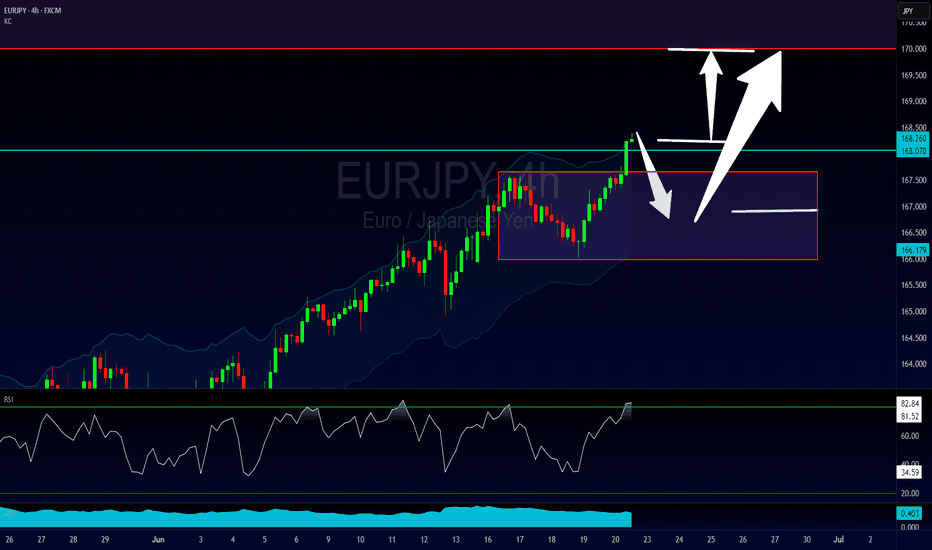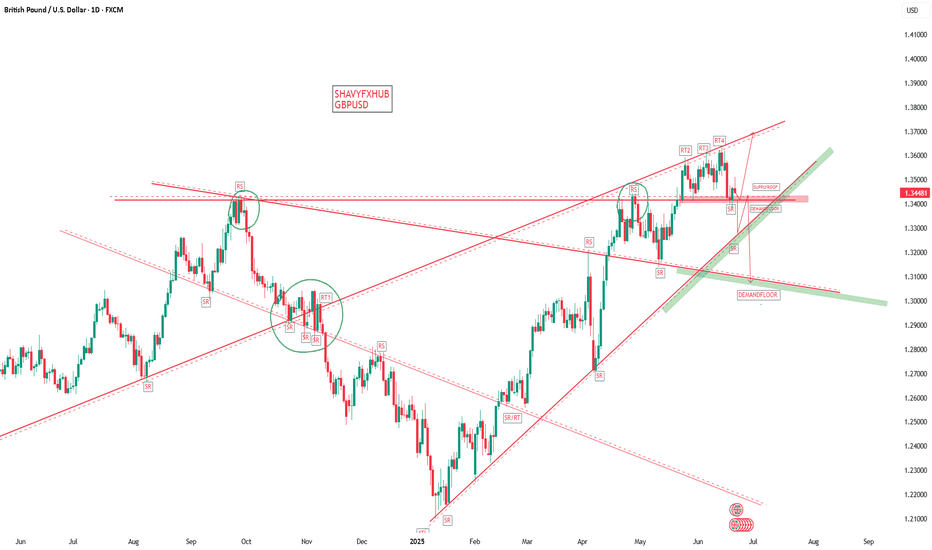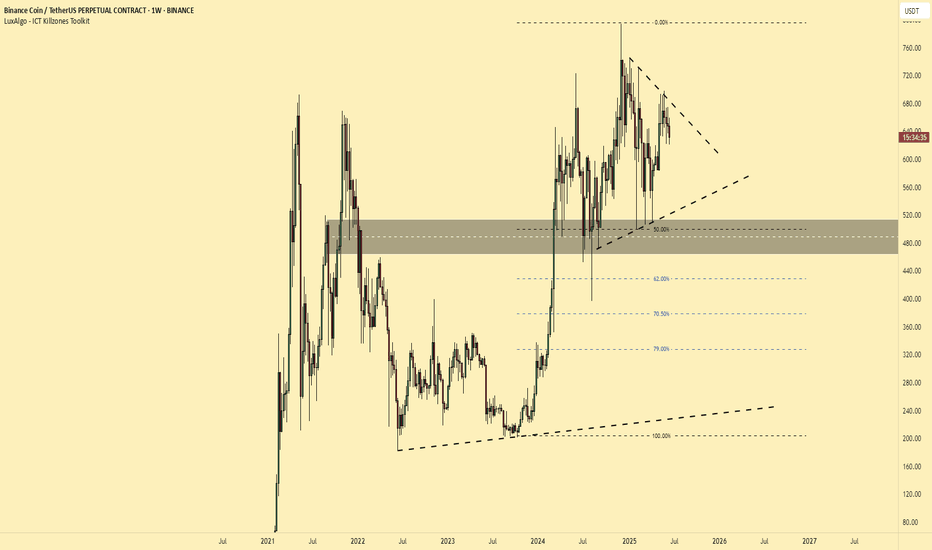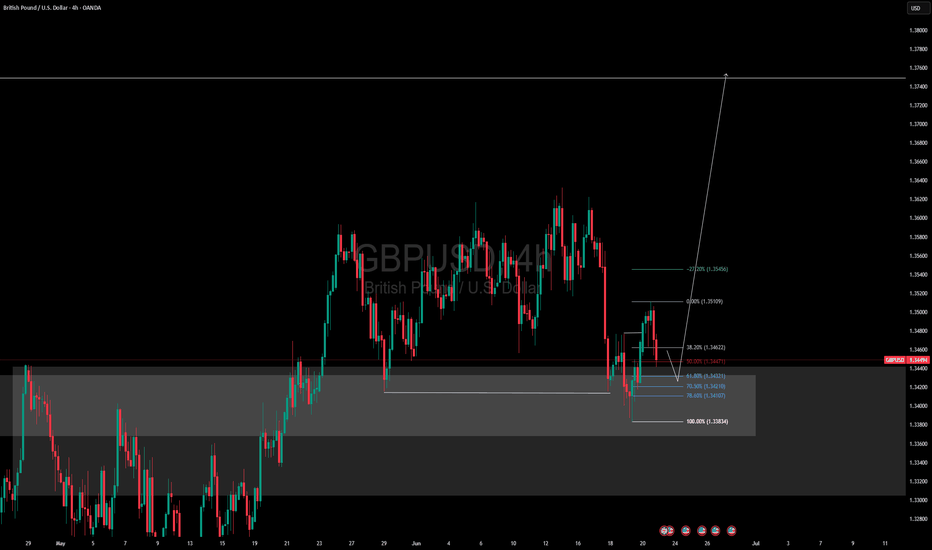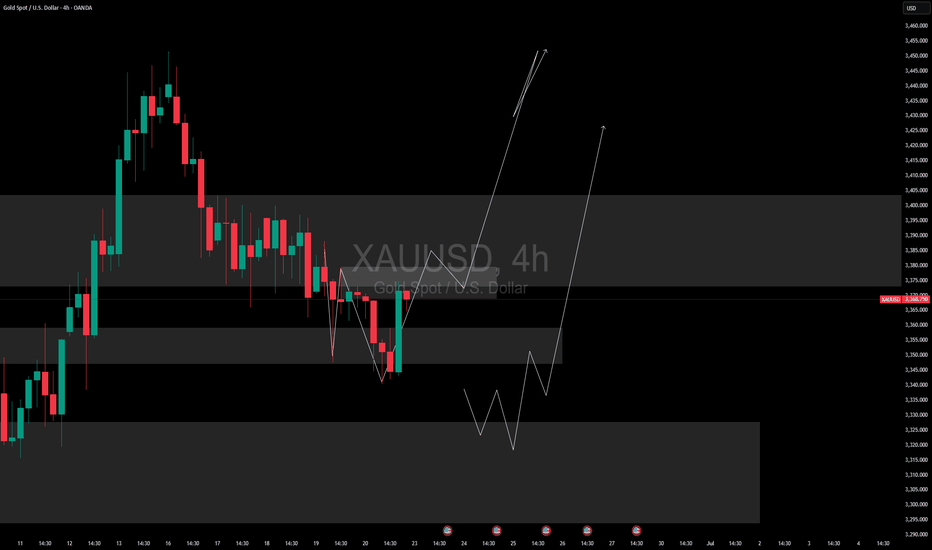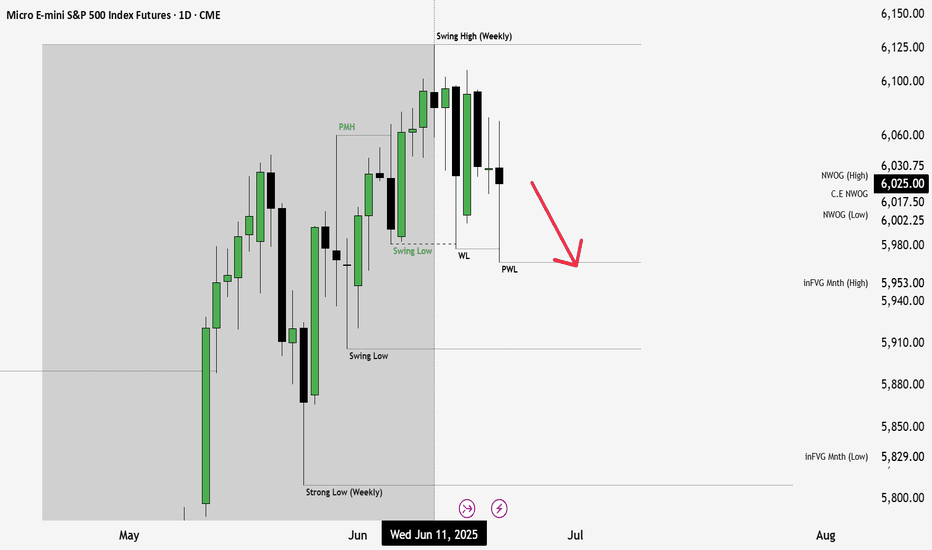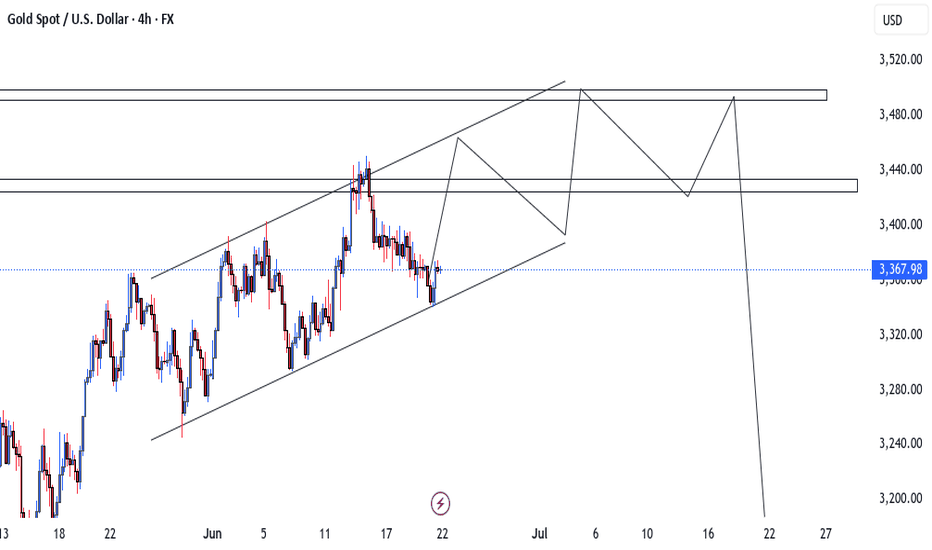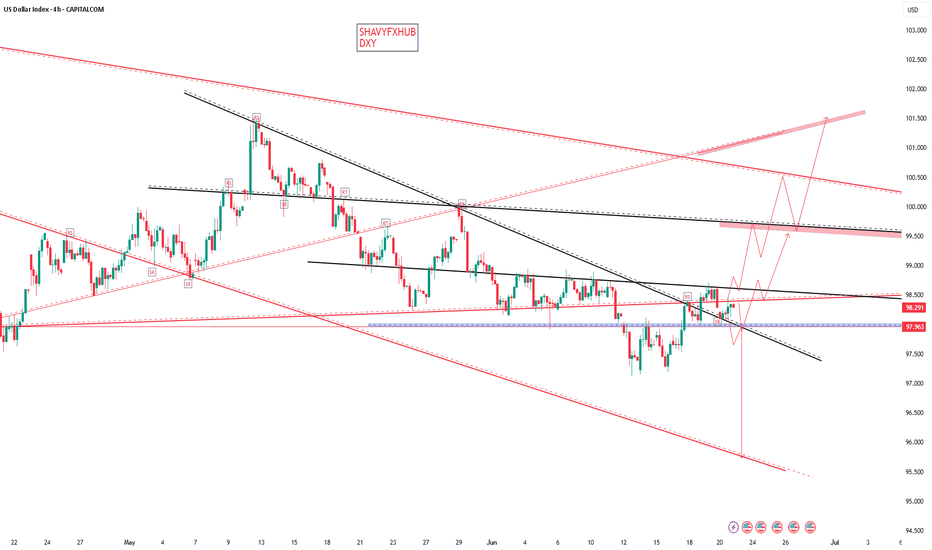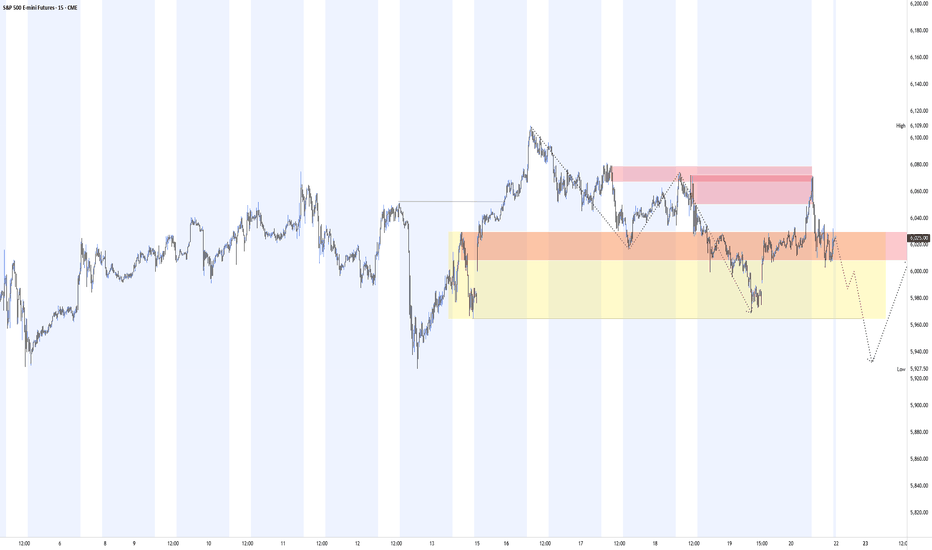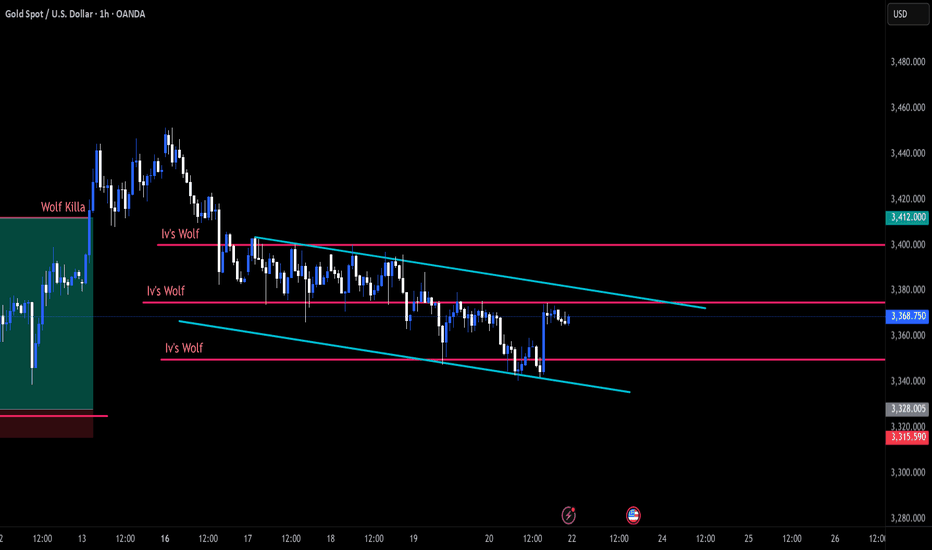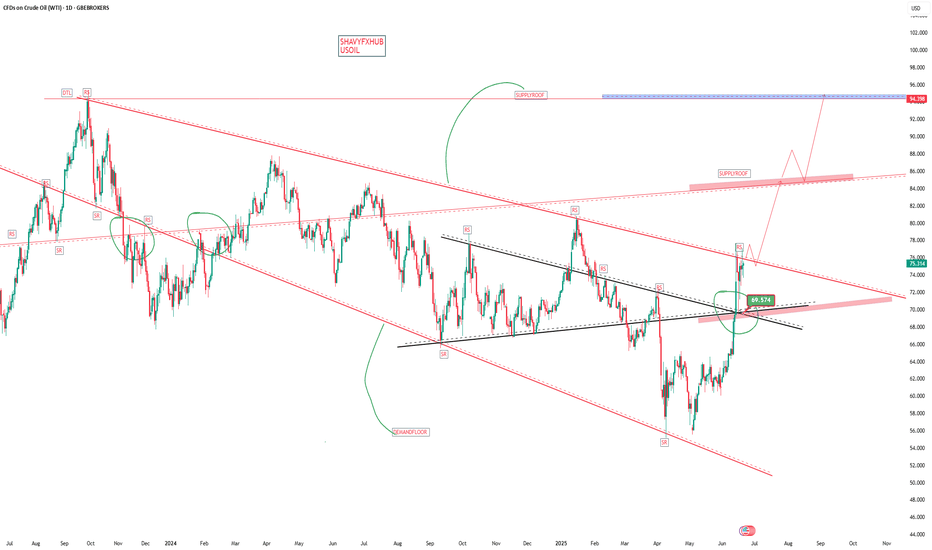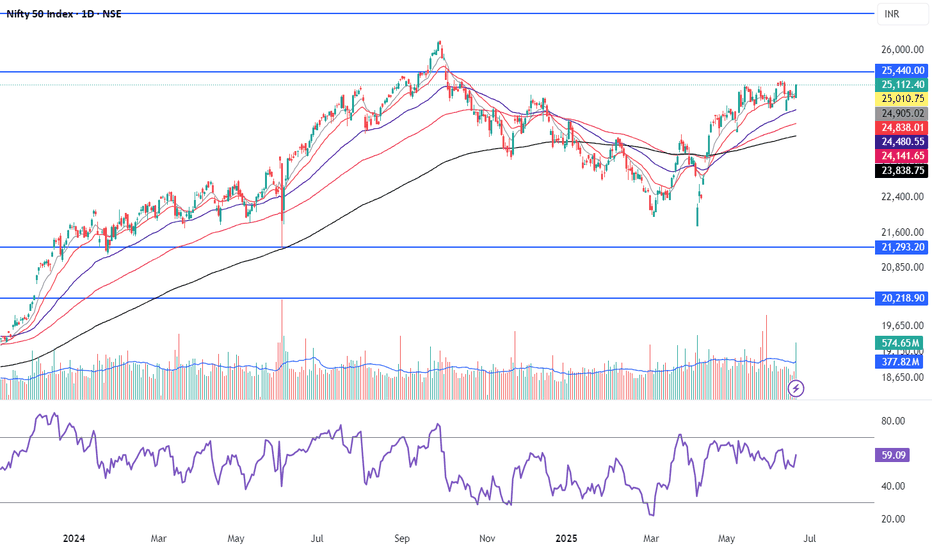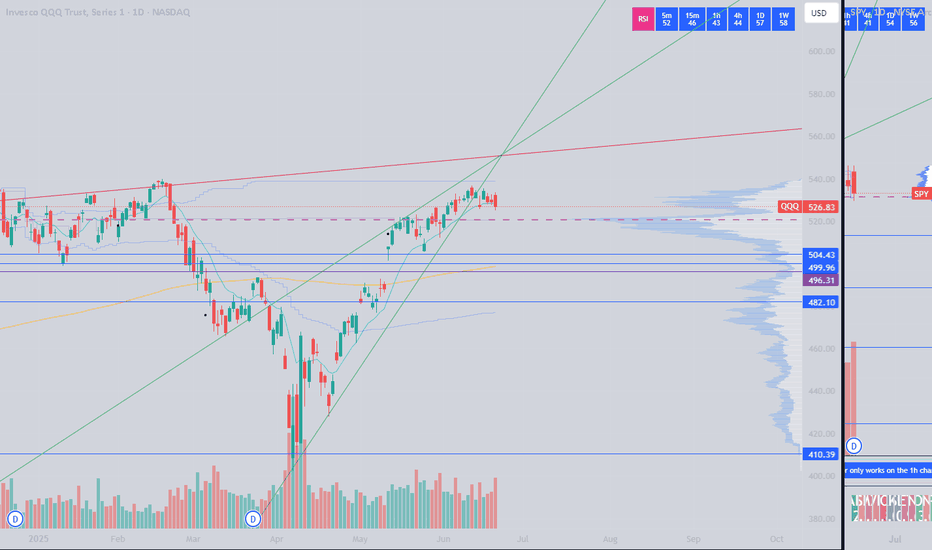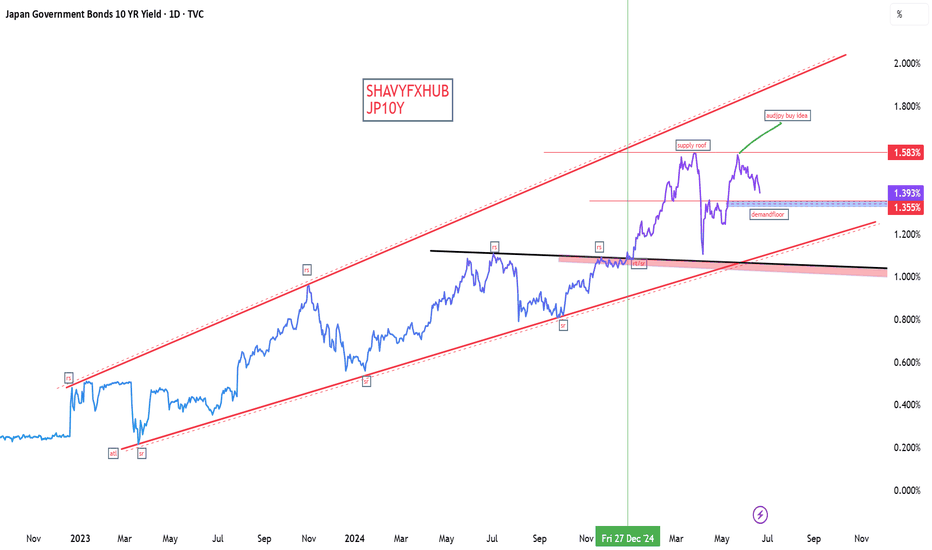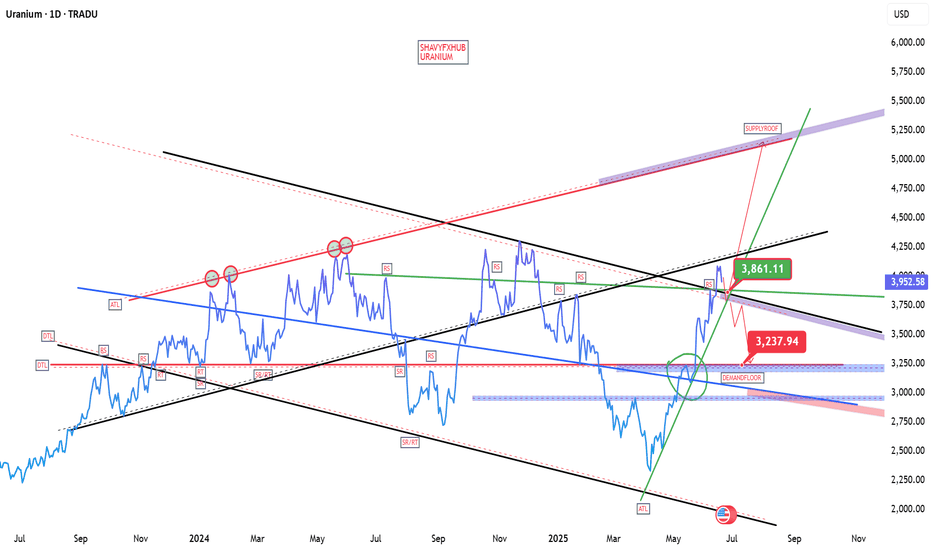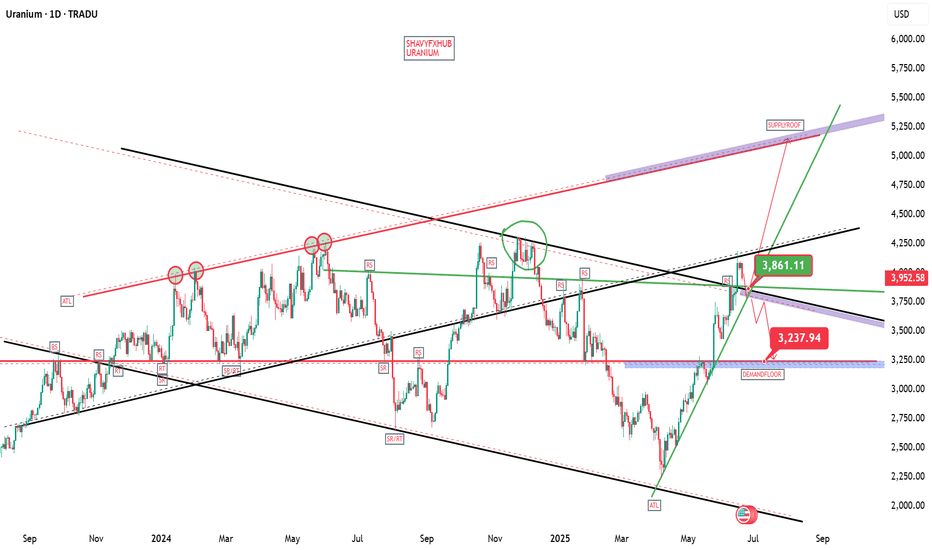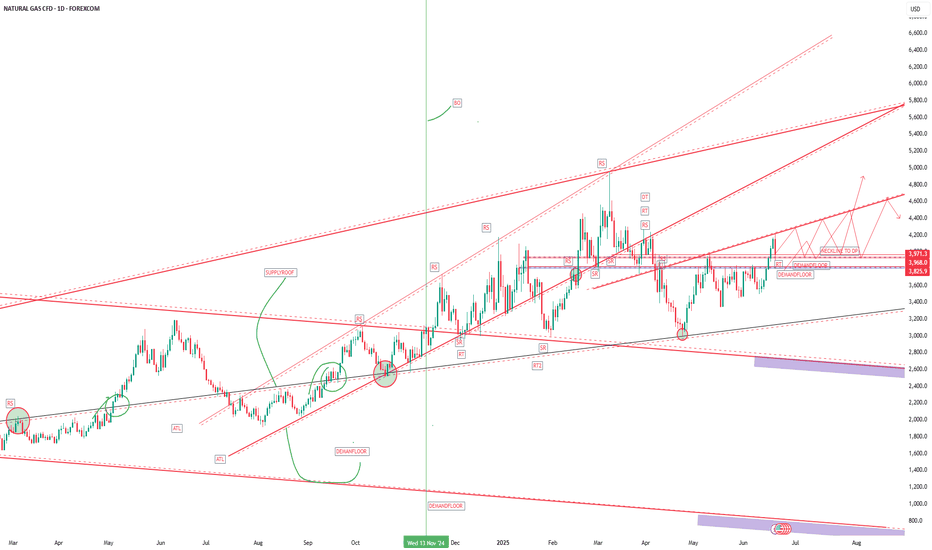ETH/USD Weekly | The Full Breakdown – Structure, Spring, and Set
This is my full Ethereum weekly chart analysis — not just what I think might happen, but a walk-through of everything I’ve mapped and labelled, based on how price has behaved since the 2021 top.
Every structure you see here is there for a reason — from the symmetrical triangle and wedge, to the Wyckoff schematics, Elliott wave flow, Spring, and more. What we’re seeing now, in my opinion, is the end of a three-year macro compression. The move that follows could define the rest of this cycle.
Let me take you through it.
After the all-time high in late 2021, Ethereum entered a structured, controlled decline. Not a crash — but a step-by-step transition through market phases. Price dropped and bottomed into a clear accumulation phase — that’s the first box on this chart, labelled as “Accumulation (cause)”. This is where smart money started taking positions, confirmed by the Spring down to 0 and the base of the move at point 2. From there, price consolidated, gained strength, and then jumped the creek — a clear breakout above the accumulation range, which gave us the confirmation for markup.
The markup phase took us from that Spring up into a five-wave impulsive move, peaking around the distribution zone. You can see it clearly — labelled Distribution, and boxed off between points A, B, C and the final wave 5. This rally failed to make new all-time highs, stalled, and was rejected cleanly. From there, we rolled over and started losing structure — and this is where it gets important.
Right after distribution, we got a breakdown I’ve labelled “Break The Ice”. This wasn’t just another dip. It was the moment we lost all structure from the markup — the line that had held the previous lows snapped, and volume stepped in. This is often the first real signal that we’ve entered the markdown phase. From a Wyckoff perspective, this breakdown is what separates Phase D from the start of a new accumulation cycle. It’s aggressive, deliberate, and clears out late longs — and that’s exactly what it did here.
Following that breakdown, we formed a new falling wedge — drawn from the top of the markdown all the way to the most recent lows. Price was making lower highs and lower lows, but with less aggression and momentum weakening. This wedge sits inside the larger symmetrical triangle, which has been developing ever since the 2021 top. The apex of this triangle, marked around $2,496, is where I believe everything will come to a head. Break that with conviction — and we could start a whole new macro leg.
But before we get there, something happened worth pointing out. That final breakdown inside the wedge? The one that dipped below and quickly reclaimed? That, for me, was the Spring. It’s labelled in yellow as “Spring” under point D. And it matches the Wyckoff schematic almost perfectly. Volume dried up on the move down. RSI and CCI both showed divergence. Then price bounced hard, reclaimed structure, and we’ve held ever since. This doesn’t look like continuation — it looks like a trap.
If that Spring holds, then we’re now in the Sign of Strength (SOS) phase. This is the moment where price reclaims its mid-structure levels, consolidates, and prepares for the breakout. We haven’t broken out yet — but the groundwork is in place.
My Elliott count also lines up. We had a 5-wave impulse from the Spring to the failed rally, followed by an ABC correction. What we may now be seeing is the completion of another Wave 2, setting up for a possible Wave 3 — the strongest wave of the cycle, if confirmed.
Now let’s talk entries. I’ve got my eye on the $2,130–$2,030 region. That’s where I’m placing my DCA bids. It’s the area just above the Spring reclaim zone, where price should react again if we retest. If we lose $1,690, I consider the Spring invalidated and will reassess. That’s my clean risk level.
Break and hold above $2,496, and the breakout is confirmed. That level is not just the wedge and triangle resistance — it’s also the psychological midpoint of this whole macro structure.
Everything’s mapped. Structure is clean. Volume is drying up. Momentum is shifting. And price is compressing right into the apex.
This isn’t a moment to chase. It’s a moment to plan.
If we break out, I’m ready to scale in. If we reject, I’ll be watching the DCA zone and the Spring level closely. Either way, I know what I’m looking for — and I know what invalidates the setup.
Let’s see what price does next.
Community ideas
Short Term USD Strength This Week! Sell The Majors?This is the FOREX futures outlook for the week of Jun 8 - 12th.
In this video, we will analyze the following FX markets:
USD Index, EUR, GBP, AUD, NZD, CAD, CHF, and JPY.
USD gained some strength on Friday's job data. Talks with China this week may add to it. But I believe the bullishness will be short term.
Look for valid sells in EUR and GBP. Be cautious with AUD and NZD. CAD and CHF will also offer opportunities to sells.
CPI Data due Wed, making that day and the days that follow potentially the best trading days this week.
Enjoy!
May profits be upon you.
Leave any questions or comments in the comment section.
I appreciate any feedback from my viewers!
Like and/or subscribe if you want more accurate analysis.
Thank you so much!
Disclaimer:
I do not provide personal investment advice and I am not a qualified licensed investment advisor.
All information found here, including any ideas, opinions, views, predictions, forecasts, commentaries, suggestions, expressed or implied herein, are for informational, entertainment or educational purposes only and should not be construed as personal investment advice. While the information provided is believed to be accurate, it may include errors or inaccuracies.
I will not and cannot be held liable for any actions you take as a result of anything you read here.
Conduct your own due diligence, or consult a licensed financial advisor or broker before making any and all investment decisions. Any investments, trades, speculations, or decisions made on the basis of any information found on this channel, expressed or implied herein, are committed at your own risk, financial or otherwise.
The End of A Trend & The Start of A New OneA few weeks ago we made an amazing bearish call of the $USDCAD. Now that it's come to an end, the market is showing signs of a potential reversal.
In this video we're going to talk about how to identify a potential reversal in trend and of course show you how I'm looking to trade it.
Please leave any questions, comments or shared ideas below.
Akil
21/06/2025 || GOLD prediction || Bullish MomentumThrough my weekly Episode multi time frame analysis , you will get deep insights .
Market in on rising channel since last year and did not respect the 2960 milestone after breaking it,Seconldy the weekly candle rejected at 3335-3338 and closes above its previous structural support at 3330-3335.
our eyes will be at 3430 first then 3520 milestone on this next weekly candle
Multi-Timeframe Analysis & Trend Continuation TradingThe EURJPY has recently violated an important level of structure leading us to make the prediction of price continuing to go higher.
In this video we'll take a look at where the next stopping point may be and what I'm waiting for the market to do in order to get involved in the trade.
If you have any questions, comments or just want to share your views/analysis, please do so below.
Akil
Live Trading Analysis: Gold (XAUUSD), GBP/USD, & USD/JPY. DailyJoin CresserRiba for an in-depth daily technical analysis of the most traded currency pairs and commodities: Gold (XAUUSD), GBP/USD, and USD/JPY. In this video, CresserRiba breaks down key price levels, identifies potential trade setups, and discusses critical market drivers influencing these instruments.
Whether you're a seasoned trader or just starting out, this analysis provides valuable insights into current market trends, support and resistance zones, and potential entry/exit points. Learn how to interpret chart patterns, understand the impact of economic news, and develop a well-informed trading strategy for XAUUSD, GBPUSD, and USDJPY.
GBPUSDDID YOU KNOW THAT YOUR COUNTRY CENTRAL BANKS HAVE ANOTHER
CENTRAL BANK AND IS CALLED BIS(BANK OF INTERNATIONAL SETTLEMENTS )???
The Bank for International Settlements (BIS) was established in 1930 at the Hague Conference, making it the world's oldest international financial institution. Its initial purpose was to facilitate the settlement of World War I reparations and to promote cooperation among central banks.
The BIS trading market refers to the role of the Bank for International Settlements (BIS) as a key intermediary and facilitator in global financial markets, particularly in foreign exchange (FX) and central bank transactions
BIS is a secretive institution with sovereign immunity that can move trillions without oversight. aka central bank of central banks in Basel Swissland with over 63 members in the world which are centrals banks of countries that make up 95% of world GDP.
Key Points about BIS and Its Trading Market Role:
Central Bank’s Central Bank: BIS acts as a bank for central banks and international organizations, providing banking services such as accounts, gold and currency transactions, asset management, and short-term collateralized loans.
Market Intermediary: BIS frequently conducts large-scale transactions on behalf of central banks in the foreign exchange and gold markets. These trades are often substantial, reflecting central banks’ reserve management or monetary policy operations.
Avoiding Market Misinterpretation: When BIS buys or sells currencies or assets, it is usually acting for a central bank, not itself, helping avoid markets mistaking these large trades for speculative or official government interventions.
Forum for Cooperation: BIS provides a platform for central banks to exchange information, coordinate policies, and cooperate on monetary and financial stability, which indirectly influences market dynamics.
Research and Statistics: BIS publishes data and analysis on global banking, FX, derivatives markets, and financial stability, supporting informed decision-making in the trading community.
Summary
The BIS trading market is not a public exchange but a specialized, high-level market where BIS facilitates and conducts financial transactions for central banks, particularly in foreign exchange and gold. Its activities help central banks manage reserves and implement monetary policy while fostering international financial cooperation.
if you know you know because BOE (BANK OF ENGLAND ) and FED (FEDERAL RESERVE ) are members .
GBPUSD 10 YEAR BOND YIELD ,INTEREST RATE ,INTEREST RATE DIFFERENTIAL AND CARRY TRADE ADVANTAGE .
1. Current Rates and Yields
Metric United Kingdom (GBP) United States (USD) Differential (UK - US)
10-Year Bond Yield 4.54% 4.38% +0.16% (16 bps)
Policy Interest Rate 4.25% 4.25%–4.50% -0.25% to -0.01%
UK Context: The Bank of England (BoE) held rates at 4.25% amid sticky inflation (3.4% YoY in May ) but signaled potential cuts in August.
US Context: The Federal Reserve held rates at 4.25%–4.50%, prioritizing inflation control despite slowing growth .
2. Interest Rate Differential and Carry Trade Advantage
Yield Spread: The UK 10-year gilt yields 0.16% more than the US 10-year Treasury, creating a modest yield pickup for GBP-denominated bonds .
Policy Rate Spread: The USD offers a 0.25% higher short-term rate (using the Fed’s 4.50% upper bound vs. BoE’s 4.25%) .
Carry Trade Mechanics:
GBP-USD Strategy: Borrow USD at 4.50% and invest in GBP assets at 4.54% (10-year gilt) for a net carry of +0.04%.
USD-GBP Strategy: Borrow GBP at 4.25% and invest in USD assets at 4.38% (10-year Treasury) for a net carry of +0.13%.
Key Risks:
Currency Volatility: GBP/USD at 1.34–1.35 could erase gains if the dollar strengthens.
Policy Shifts: BoE rate cuts (expected August 2025) may narrow the yield spread , while Fed cuts could reduce USD rate advantages .
3. Market Outlook
UK Focus: Inflation persistence may delay BoE cuts, supporting GBP yields near-term .
US Focus: Fed’s "higher for longer" stance and tariff-related inflation risks could sustain USD yield appeal .
Carry Viability: The USD-GBP strategy offers a slight edge (0.13% carry) but requires hedging against GBP appreciation risks.
Summary
Yield Advantage: UK 10-year gilts yield 0.16% more than US Treasuries, but USD short-term rates are 0.25% higher.
Optimal Carry: Borrowing GBP to invest in USD assets (0.13% carry) is marginally favorable, though policy uncertainty warrants caution.
Critical Factors: Monitor BoE/Fed rate decisions and GBP/USD trends for carry trade adjustments.
GBPUSD MULTI TIME FRAME ANALYSIS Hello traders , here is the full multi time frame analysis for this pair, let me know in the comment section below if you have any questions , the entry will be taken only if all rules of the strategies will be satisfied. wait for more price action to develop before taking any position. I suggest you keep this pair on your watchlist and see if the rules of your strategy are satisfied.
🧠💡 Share your unique analysis, thoughts, and ideas in the comments section below. I'm excited to hear your perspective on this pair .
💭🔍 Don't hesitate to comment if you have any questions or queries regarding this analysis.
Can we look for longs on XAUUSD? my MTF POVHello traders , here is the full multi time frame analysis for this pair, let me know in the comment section below if you have any questions , the entry will be taken only if all rules of the strategies will be satisfied. wait for more price action to develop before taking any position. I suggest you keep this pair on your watchlist and see if the rules of your strategy are satisfied.
🧠💡 Share your unique analysis, thoughts, and ideas in the comments section below. I'm excited to hear your perspective on this pair .
💭🔍 Don't hesitate to comment if you have any questions or queries regarding this analysis.
We may see lower prices for S&P FuturesHi Trading Community,
Over the past few weeks, I've been emphasizing the bullish nature of the market. However, in today’s video, I’m urging caution on long positions. Given current geopolitical trends and the recent candlestick formations, there’s a possibility we could see lower prices on the ES.
Join me as I walk through a revised top-down analysis of the ES for this new September contract period.
June 21st Market Recap (gold,gbpusd,eurusd)In this video I discuss what I was looking for the market to do past week as well as following week however I'm not a financial advisor I'm just posting my prediction if traded trade at own risk with proper risk management. Btw I appreciate all the feed back and if you find my videos insightful follow my YouTube channel @sbetrades
DOLLAR INDEXThe relationship between the US Dollar Index (DXY) and the 10-year US Treasury yield is generally positive but has shown signs of weakening and occasional breakdowns recently.
Key Points:
Typical Positive Correlation:
Historically, when the 10-year Treasury yield rises, the dollar tends to strengthen, and when yields fall, the dollar weakens. This is because higher yields attract foreign capital seeking better returns, increasing demand for the dollar. Conversely, lower yields reduce dollar appeal.
Mechanism:
The 10-year yield reflects investor expectations about inflation, economic growth, and Federal Reserve policy. Higher yields often signal stronger growth or inflation, supporting a stronger dollar due to higher real returns on US assets.
Recent Weakening of Correlation:
Since early 2025, this positive correlation has weakened significantly. Despite rising 10-year yields (around 4.4% to 4.5%), the DXY has hovered near the 98–99 range and even declined over 10% year-to-date. This divergence is attributed to:
Investors re-evaluating the dollar’s reserve currency status and shifting capital to other markets (e.g., European equities).
Outflows from US assets amid geopolitical and economic uncertainty.
Asynchronous monetary policy cycles globally, with some central banks hiking or cutting rates at different paces than the Fed.
Market Sentiment and Safe-Haven Flows:
In times of stress, the dollar’s traditional role as a safe haven can be challenged, further complicating the yield-dollar relationship.
Conclusion
While the 10-year Treasury yield and the US dollar index usually move together, recent market dynamics have disrupted this pattern. Rising yields have not translated into a stronger dollar in 2025, reflecting broader shifts in investor sentiment, geopolitical risks, and global monetary policy divergence.
S&P 500 E-mini Futures In the S&P 500 futures (/ES), a decisive break and close below 5965 would confirm bearish structure on the higher time frames, signaling a shift in market sentiment. Following the break, we anticipate a corrective pullback toward the 6000–6010 supply zone. This retracement can offer an optimal short entry, with the initial downside target set at 5900, aligned with the next liquidity pool and previous demand zone
USOIL WTIKey Offshore Oil and Gas Installations at Risk of Iranian Attack
Based on recent escalations and Iran's retaliatory capabilities, the following offshore installations are most vulnerable:
Strait of Hormuz Infrastructure
Why at risk: A critical global chokepoint handling 21 million barrels of oil daily. Iran has repeatedly threatened closure if provoked.
Potential targets: Tanker routes, underwater pipelines, and monitoring stations.
Qatar’s North Field Gas Facilities
Why at risk: Directly adjacent to Iran’s South Pars field (recently attacked by Israel). Shared reservoirs mean disruptions could cascade.
Vulnerability: Iran could target Qatari platforms to amplify global gas shortages.
Saudi/UAE Offshore Fields
Key sites:
Saudi Arabia’s Safaniya (world’s largest offshore oil field).
UAE’s Upper Zakum oil field.
Why at risk: Iran views Gulf states as Israeli allies; striking them would disrupt U.S.-aligned economies.
Israeli Mediterranean Gas Rigs
Leviathan and Tamar fields:
Provide 90% of Israel’s electricity.
Already targeted by Iranian proxies (e.g., Hezbollah rockets in 2023).
Bahrain/Kuwait Offshore Facilities
Strategic value: Proximity to Iran enables rapid drone/missile strikes. Past attacks (e.g., 2019 Aramco) demonstrate capability.
Why These Targets?
Retaliatory logic: Iran’s energy infrastructure (e.g., South Pars) was damaged by Israeli strikes. Targeting adversaries’ assets aligns with its "escalate to deter" strategy.
Global leverage: Disrupting Hormuz or major fields could spike oil prices 30–50%, pressuring Western governments.
Technical feasibility: Iran’s naval drones, cruise missiles, and mines can penetrate offshore defenses.
Immediate Threats
Target Risk Level Potential Impact
Strait of Hormuz Critical Global oil prices surge; 20% of LNG shipments halted
Qatar’s North Field High 10% of global LNG supply disrupted; Europe/Asia energy crisis
Israeli Gas Rigs High Israel’s energy security crippled; regional conflict escalation
Conclusion
Iran’s most likely retaliation targets are offshore installations in the Strait of Hormuz, Qatar, and Israeli Mediterranean fields, leveraging proximity and asymmetric tactics. Such attacks would aim to inflict maximum economic damage while avoiding direct confrontation with the U.S. or NATO. Global energy markets face severe disruption if hostilities escalate further.
A successful breakout above this descending trendline and resistance zone (near $74–$75) would confirm a bullish reversal, potentially opening the way for further upside toward $80 and $100 as next target.
US crude inventories have declined recently, reducing oversupply fears and supporting prices.
Global oil demand is forecast to grow by 720,000 barrels per day in 2025, while supply increases are more modest.
OPEC+ decisions to maintain production cuts or limit increases have also contributed to price support.
Summary
Oil prices are testing and potentially breaking out of a long-term descending trendline formed since mid-2022.
breakout will be long buy hope that we see 80$ per barrel.
#usoil #oil
WTI USOIL WEEKLY CHARTKey Offshore Oil and Gas Installations at Risk of Iranian Attack
Based on recent escalations and Iran's retaliatory capabilities, the following offshore installations are most vulnerable:
Strait of Hormuz Infrastructure
Why at risk: A critical global chokepoint handling 21 million barrels of oil daily. Iran has repeatedly threatened closure if provoked.
Potential targets: Tanker routes, underwater pipelines, and monitoring stations.
Qatar’s North Field Gas Facilities
Why at risk: Directly adjacent to Iran’s South Pars field (recently attacked by Israel). Shared reservoirs mean disruptions could cascade.
Vulnerability: Iran could target Qatari platforms to amplify global gas shortages.
Saudi/UAE Offshore Fields
Key sites:
Saudi Arabia’s Safaniya (world’s largest offshore oil field).
UAE’s Upper Zakum oil field.
Why at risk: Iran views Gulf states as Israeli allies; striking them would disrupt U.S.-aligned economies.
Israeli Mediterranean Gas Rigs
Leviathan and Tamar fields:
Provide 90% of Israel’s electricity.
Already targeted by Iranian proxies (e.g., Hezbollah rockets in 2023).
Bahrain/Kuwait Offshore Facilities
Strategic value: Proximity to Iran enables rapid drone/missile strikes. Past attacks (e.g., 2019 Aramco) demonstrate capability.
Why These Targets?
Retaliatory logic: Iran’s energy infrastructure (e.g., South Pars) was damaged by Israeli strikes. Targeting adversaries’ assets aligns with its "escalate to deter" strategy.
Global leverage: Disrupting Hormuz or major fields could spike oil prices 30–50%, pressuring Western governments.
Technical feasibility: Iran’s naval drones, cruise missiles, and mines can penetrate offshore defenses.
Immediate Threats
Target Risk Level Potential Impact
Strait of Hormuz Critical Global oil prices surge; 20% of LNG shipments halted
Qatar’s North Field High 10% of global LNG supply disrupted; Europe/Asia energy crisis
Israeli Gas Rigs High Israel’s energy security crippled; regional conflict escalation
Conclusion
Iran’s most likely retaliation targets are offshore installations in the Strait of Hormuz, Qatar, and Israeli Mediterranean fields, leveraging proximity and asymmetric tactics. Such attacks would aim to inflict maximum economic damage while avoiding direct confrontation with the U.S. or NATO. Global energy markets face severe disruption if hostilities escalate further.
A successful breakout above this descending trendline and resistance zone (near $74–$75) would confirm a bullish reversal, potentially opening the way for further upside toward $80 and $100 as next target.
US crude inventories have declined recently, reducing oversupply fears and supporting prices.
Global oil demand is forecast to grow by 720,000 barrels per day in 2025, while supply increases are more modest.
OPEC+ decisions to maintain production cuts or limit increases have also contributed to price support.
Summary
Oil prices are testing and potentially breaking out of a long-term descending trendline formed since mid-2022.
breakout will be long buy hope that we see 80$ per barrel.
#usoil #oil
10 YEAR JAPANESE GOVERNMENT BOND YIELD JGB10Y1. Japan 10-Year Government Bond Yield and Price
The 10-year Japanese Government Bond (JGB) yield is around 1.40% to 1.52% in mid-2025, recently easing slightly to about 1.40% on June 20, 2025.
This yield level is significantly higher than the near-zero levels seen in previous years but remains low by global standards.
The bond price for the 10-year JGB hovers near 99.6 to 100, reflecting the inverse relationship with yields (as yields rise, bond prices fall slightly).
Japan’s bond yields have been rising steadily since 2022, reflecting market concerns about inflation, fiscal sustainability, and monetary policy shifts.
2. Bank of Japan (BoJ) Interest Rate Policy
The official BoJ short-term policy rate is currently at 0.50%, up from negative territory (-0.10%) a year ago.
The BoJ has maintained a very accommodative monetary policy stance but has started to allow some upward flexibility in long-term yields, including the 10-year JGB yield, moving away from strict yield curve control.
The BoJ is also considering buying back some super-long government bonds to stabilize the market amid rising yields.
3. Relationship Between Bond Yields, Prices, and JPY Strength
Bond yields and prices have an inverse relationship: as yields rise (reflecting higher interest rates or inflation expectations), bond prices fall.
JPY Strength is influenced by several factors related to bond yields and interest rates:
Rising Japanese bond yields tend to support a stronger yen, as higher yields attract foreign capital seeking better returns.
However, Japan’s yields remain much lower than those of other major economies (e.g., US 10-year yield ~4.4%), which limits yen appreciation.
The BoJ’s accommodative policy and yield curve control have historically kept yields low, suppressing JPY strength relative to currencies like USD.
Recent yield increases and policy shifts have led to some yen appreciation, but trade and geopolitical factors also play significant roles.
The trade deficit narrowing and ongoing trade talks with the US may also impact the yen’s value.
Conclusion
Japan’s 10-year government bond yield has risen modestly to around 1.4%, reflecting gradual monetary policy normalization by the BoJ, which still maintains a very low short-term interest rate of 0.5%. This yield increase supports some yen strength by attracting capital inflows, although the yen remains sensitive to global yield differentials and trade dynamics. Bond prices have adjusted accordingly, declining slightly as yields rose. The BoJ’s interventions, including potential bond buybacks, aim to manage market volatility amid these shifts.
JGB 10-Year vs. AU 10-Year Bond Yield Differential and Related Concepts
1. Current Yield Differential (June 2025)
The Australia 10-Year Government Bond yield is approximately 4.33% to 4.32% (recently around 4.31%).
The Japan 10-Year Government Bond (JGB) yield is about 1.40% to 1.52%, with recent figures near 1.40%.
This results in a yield spread (Australia minus Japan) of roughly 278 to 365 basis points (2.78% to 3.65%), meaning Australian 10Y bonds yield significantly more than Japanese 10Y bonds.
2. Carry Trade and Yield Differential
The carry trade involves borrowing in a low-yield currency (e.g., Japanese yen) and investing in a high-yield currency (e.g., Australian dollar) to profit from the interest rate differential.
Given the large yield spread (~3%), investors can earn positive carry by borrowing JPY at low rates (~0.5%) and investing in AUD bonds yielding above 4%.
However, carry trade profits depend on currency movements: if the AUD depreciates against the JPY, gains can be eroded or losses incurred.
3. Uncovered Interest Rate Parity (UIP)
UIP theory states that the expected change in exchange rates offsets interest rate differentials, implying no arbitrage profits from carry trades.
For example, if Australian yields are 3% higher than Japanese yields, the AUD is expected to depreciate approximately 3% versus the JPY over the investment horizon.
Empirically, UIP often fails in the short term, allowing carry trade profits, but tends to hold over the long term.
4. Covered Interest Rate Parity (CIP)
CIP states that the forward exchange rate between two currencies should reflect the interest rate differential, eliminating arbitrage opportunities via forward contracts.
In practice, CIP generally holds in developed markets, meaning investors can hedge currency risk using forward contracts, locking in the carry trade return minus hedging costs.
Deviations from CIP can occur but are usually small and short-lived in major currency pairs like AUD/JPY.
Summary Table
Aspect Details
Australia 10Y Yield ~4.31%
Japan 10Y Yield ~1.40%
Yield Spread (AU - JGB) ~2.78% to 3.65% (278–365 basis points)
Carry Trade Borrow JPY at low rates, invest in AUD for yield pickup
UIP Exchange rate expected to depreciate AUD by yield diff.
CIP Forward rates reflect interest differential, hedging possible
Implications for Investors and Markets
The large yield differential incentivizes carry trades from JPY to AUD, contributing to capital flows and exchange rate dynamics.
Short-term carry trade profits arise due to UIP deviations but are subject to currency risk.
CIP arbitrage ensures that hedged carry trades have limited risk-free profits, but unhedged positions carry exchange rate exposure.
Central bank policies, geopolitical events, and market sentiment can cause fluctuations in yields and exchange rates, impacting carry trade viability.
#BOJ
uraniumThe 10-year Treasury bond yield plays a significant role in the energy markets, including uranium, by influencing financing costs, investment decisions, and broader economic sentiment, which in turn affect uranium demand and pricing dynamics.
Significance of the 10-Year Bond Yield in Uranium and Energy Markets:
Benchmark for Financing Costs
The 10-year Treasury yield serves as a benchmark for long-term borrowing costs for utilities and mining companies involved in uranium production and nuclear energy infrastructure.
Higher yields increase the cost of capital, potentially delaying or raising the cost of new uranium mine developments and nuclear plant investments. Conversely, lower yields reduce financing costs, supporting expansion and production.
Indicator of Economic and Inflation Expectations
Rising 10-year yields often signal expectations of stronger economic growth and inflation, which can boost energy demand, including uranium for nuclear power generation.
Declining yields typically reflect economic caution or slowdown, which may temper energy demand growth.
Impact on Utility Procurement Behavior
As uranium accounts for only about 5–10% of nuclear power generation costs, utilities prioritize securing supply to avoid operational disruptions, even at higher prices.
When bond yields are stable or falling (indicating lower financing costs and economic uncertainty), utilities are more likely to lock in long-term uranium contracts aggressively, driving prices higher.
Recent market conditions with the 10-year yield around 4.5% have coincided with utilities purchasing uranium in record quantities, pushing prices to 15-year highs.
Geopolitical and Supply Risk Amplification
The uranium market is sensitive to geopolitical risks, especially given that over half of global uranium supply and processing is controlled by countries within Russia’s sphere of influence.
Rising bond yields amid geopolitical tensions can increase risk premiums on uranium prices as investors and utilities seek supply security.
Investor Confidence and Capital Flows
The 10-year Treasury yield reflects investor confidence and risk appetite. Higher yields can attract capital away from commodities toward fixed income, potentially dampening speculative interest in uranium.
Conversely, lower yields can boost commodity investment appeal as investors seek higher returns, supporting uranium prices.
In essence, the 10-year Treasury yield is a crucial macro-financial gauge that indirectly shapes uranium market dynamics by affecting financing, demand expectations, and risk perceptions, thereby influencing uranium prices and investment decisions in the energy sector.
Key Use Cases of Uranium
Uranium serves critical functions across multiple sectors:
Nuclear Energy Fuel for commercial reactors generating electricity which Provides 10% of global electricity with low carbon emissions
Medical Isotopes ,the Production of radioisotopes (e.g., Technetium-99m) Enables cancer diagnostics and treatment through PET scans
the Military/Defense use uranium for Nuclear weapons , naval propulsion systems and the Powering of submarines and aircraft carriers
Space Exploration using Nuclear thermal propulsion with Potential fuel for long-duration space missions.
Scientific Research and Geological dating and particle physics which Studies earth's age and fundamental particles all apply uranium .
Demand drivers:
72 new nuclear reactors under construction globally (as of 2025)
Medical isotope market growth (7.2% CAGR projected)
Space agency investments in nuclear propulsion
Investment Considerations
Price volatility: Uranium spot prices impact producer profitability but long-term contracts provide stability
Sector-specific risks: Regulatory constraints, waste management challenges, and geopolitical factors affect uranium investments
Growth areas: Small modular reactors (SMRs) and radioisotope production represent emerging opportunities
Conclusion: Uranium's value stems from its diverse applications in energy, medicine, defense, and science. While no dedicated "uranium bond" exists, the sector's performance is reflected in mining stocks and long-term contracts. The metal's fundamental importance in clean energy and advanced technology underpins its long-term market position.
URANIUMThe 10-year Treasury bond yield plays a significant role in the energy markets, including uranium, by influencing financing costs, investment decisions, and broader economic sentiment, which in turn affect uranium demand and pricing dynamics.
Significance of the 10-Year Bond Yield in Uranium and Energy Markets:
Benchmark for Financing Costs
The 10-year Treasury yield serves as a benchmark for long-term borrowing costs for utilities and mining companies involved in uranium production and nuclear energy infrastructure.
Higher yields increase the cost of capital, potentially delaying or raising the cost of new uranium mine developments and nuclear plant investments. Conversely, lower yields reduce financing costs, supporting expansion and production.
Indicator of Economic and Inflation Expectations
Rising 10-year yields often signal expectations of stronger economic growth and inflation, which can boost energy demand, including uranium for nuclear power generation.
Declining yields typically reflect economic caution or slowdown, which may temper energy demand growth.
Impact on Utility Procurement Behavior
As uranium accounts for only about 5–10% of nuclear power generation costs, utilities prioritize securing supply to avoid operational disruptions, even at higher prices.
When bond yields are stable or falling (indicating lower financing costs and economic uncertainty), utilities are more likely to lock in long-term uranium contracts aggressively, driving prices higher.
Recent market conditions with the 10-year yield around 4.5% have coincided with utilities purchasing uranium in record quantities, pushing prices to 15-year highs.
Geopolitical and Supply Risk Amplification
The uranium market is sensitive to geopolitical risks, especially given that over half of global uranium supply and processing is controlled by countries within Russia’s sphere of influence.
Rising bond yields amid geopolitical tensions can increase risk premiums on uranium prices as investors and utilities seek supply security.
Investor Confidence and Capital Flows
The 10-year Treasury yield reflects investor confidence and risk appetite. Higher yields can attract capital away from commodities toward fixed income, potentially dampening speculative interest in uranium.
Conversely, lower yields can boost commodity investment appeal as investors seek higher returns, supporting uranium prices.
In essence, the 10-year Treasury yield is a crucial macro-financial gauge that indirectly shapes uranium market dynamics by affecting financing, demand expectations, and risk perceptions, thereby influencing uranium prices and investment decisions in the energy sector.
Key Use Cases of Uranium
Uranium serves critical functions across multiple sectors:
Nuclear Energy Fuel for commercial reactors generating electricity which Provides 10% of global electricity with low carbon emissions
Medical Isotopes ,the Production of radioisotopes (e.g., Technetium-99m) Enables cancer diagnostics and treatment through PET scans
the Military/Defense use uranium for Nuclear weapons , naval propulsion systems and the Powering of submarines and aircraft carriers
Space Exploration using Nuclear thermal propulsion with Potential fuel for long-duration space missions.
Scientific Research and Geological dating and particle physics which Studies earth's age and fundamental particles all apply uranium .
Demand drivers:
72 new nuclear reactors under construction globally (as of 2025)
Medical isotope market growth (7.2% CAGR projected)
Space agency investments in nuclear propulsion
Investment Considerations
Price volatility: Uranium spot prices impact producer profitability but long-term contracts provide stability
Sector-specific risks: Regulatory constraints, waste management challenges, and geopolitical factors affect uranium investments
Growth areas: Small modular reactors (SMRs) and radioisotope production represent emerging opportunities
Conclusion: Uranium's value stems from its diverse applications in energy, medicine, defense, and science. While no dedicated "uranium bond" exists, the sector's performance is reflected in mining stocks and long-term contracts. The metal's fundamental importance in clean energy and advanced technology underpins its long-term market position.
NATURAL GAS XNGUSDCorrelations: Natural Gas, Bond Yields (US10Y), DXY, and Seasonal Patterns
1. Natural Gas and 10-Year Treasury Yield (US10Y)
Positive Correlation: Natural gas prices and the 10-year Treasury yield tend to move in tandem, driven by shared macroeconomic forces like inflation expectations and growth outlooks.
Mechanism: Rising yields signal economic strength or inflation, boosting industrial/energy demand and gas prices. Conversely, falling yields often align with gas price declines during economic softening.
2. Natural Gas and US Dollar Index (DXY)
Inverse Relationship (Historically): A stronger dollar (DXY↑) typically pressures natural gas prices, as dollar-denominated commodities become costlier for global buyers, reducing demand.
Exception: During extreme supply disruptions (e.g., geopolitical crises), a strong dollar and gas prices can rise together if global energy shortages override currency effects.
Recent Weakness: This correlation has diminished in 2024–2025, with DXY and gas prices occasionally moving independently amid supply shocks (e.g., LNG export surges).
3. Seasonal Impact on Natural Gas (Winter vs. Summer)
Winter (Peak Demand):
Demand: Heating needs (residential/commercial) drive consumption to yearly highs (e.g., 30+ Bcf/d in U.S. residential use).
Price Impact: Colder winters amplify price spikes, especially if storage inventories are low or supply chain disruptions occur.
Summer (Secondary Peak):
Demand: Electricity generation for cooling sustains demand, though typically below winter peaks.
Price Impact: Heatwaves can cause short-term surges, but prices generally remain lower than in winter.
4. Seasonal Influence on Correlations
Winter:
US10Y Correlation Strengthens: Inflation fears from heating demand can push yields and gas prices higher together.
DXY Correlation Weakens: Geopolitical supply risks (e.g., Russia-Ukraine tensions) may decouple gas from dollar strength.
Summer:
US10Y Correlation Muted: Cooling demand is less inflation-sensitive, weakening the gas-yield link.
DXY Correlation Resumes: Stronger dollar more consistently pressures gas prices absent winter-like crises.
Key Drivers Macro growth/inflation expectations Global trade costs, currency flows Weather, storage levels
Conclusion
Natural gas exhibits a strong positive correlation with 10-year yields (driven by shared macro sensitivity) and a historically inverse link to the dollar (though recently unstable). Seasonal peaks in winter amplify gas-yield ties due to inflation risks, while summer realigns gas with dollar dynamics. Geopolitical or supply shocks can override these patterns, particularly in winter.
#DOLLAR #GAS
